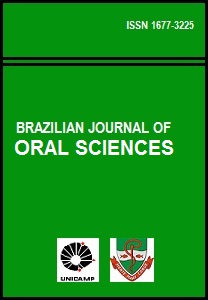Abstract
Fiber posts are usually luted to the root canal with dual-cured resin cements. However, some of these cements require light-activation in order to reach optimal degree of cure. The aim of this study was to evaluate the effect of the fiber post type on microhardness of a dualcured resin cement used for luting these posts. After endodontic treatment, four fiber post types were luted to the root canal of bovine incisors with RelyX ARC. The samples were sectioned in order to obtain four slices, representing different depths (0.0; 2.5; 5.0; 7.5 and 10.0mm). Knoop microhardness testing was performed in each slice. The data were submitted to split-plot ANOVA and Tukey post-hoc tests. An additional sample per fiber post type was used to analyze bonding interface by SEM. At the depths of 0 and 2.5 mm, the resin cement presented the highest hardness values. The lowest values were observed at the 10 mm depth, and the resin cement presented intermediary hardness means at the depths of 5 mm and 7.5 mm. By means of scanning electronic microscopy, it was possible to see the more homogeneous hybrid layer in the cervical region of the root.References
Peroz I, Blankenstein F, Lange KP, Naumann M. Restoring endodontically treated teeth with posts and cores—a review. Quintessence Int. 2005; 36: 737-46.
Seefeld F, Wenz HJ, Ludwig K, Kem M. Resistance to fracture and structural characteristics of different fiber reinforced post systems. Dent Mater. 2007; 23: 265-271.
Hagge MS, Wong RD, Lindemuth JS. Retention strengths of five luting cements on prefabricated dowels after root canal obturation with a zinc oxide/eugenol sealer: 1. Dowel space preparation/ cementation at one week after obturation. J Prosthodont. 2002; 11: 168-75.
Braga RR, Cesar PF, Gonzaga CC. Mechanical properties of resin cements with different activation modes. J Oral Rehabil. 2002; 29: 257-62.
Kumbuloglu O, Lassila LV, User A, Vallittu PK. A study of the physical and chemical properties of four resin composite luting cements. Int J Prosthodont. 2004; 17: 357-63.
Harashima I, Nomata T, Hirasawa T. Degree of conversion of dual-cured composite luting cements. Dent Mater J. 1991; 10: 8-17.
Chen YC, Ferracane JL, Prahl AS. A pilot study of a simple photon migration model for predicting depth of cure in dental composite. Dent Mater. 2005; 21: 1075-86.
Roberts HW, Leonard DL, Vandewalle KS, Cohen ME, Charlton DG. The effect of a translucent post on resin composite depth of cure. Dent Mater. 2004; 20: 617-22.
Yoldas O, Alacam T. Microhardness of composites in simulated root canals cured with light transmitting posts and glass-fiber reinforced composite posts. J Endod. 2005; 31: 104-6.
DeWald JP, Ferracane JL. A comparison of four modes of evaluating depth of cure of light-activated composites. J Dent Res. 1987; 66: 727-30.
Chung KH, Greener EH. Correlation between degree of conversion, filler concentration and mechanical properties of posterior composite resins. J Oral Rehabil. 1990; 17: 487-94.
Rueggeberg FA, Craig RG. Correlation of parameters used to estimate monomer conversion in a light-cured composite. J Dent Res. 1988; 67: 932-7.
Elliott JE, Lovell LG, Bowman CN. Primary cyclization in the polymerization of bis-GMA and TEGDMA: a modeling approach to understanding the cure of dental resins. Dent Mater. 2001; 17: 221-9.
Andrzejewska E. Kinetics of network formation during photopolymerization. Trans Acad Dent Mater. 2004; 18: 69-80.
Watts DC. Reaction kinetics and mechanics in photopolymerized networks. Dent Mater. 2005; 21: 27-35.
Caughman WF, Chan DC, Rueggeberg FA. Curing potential of dual-polymerizable resin cements in simulated clinical situations. J Prosthet Dent. 2001; 86: 101-6.
Sigemori RM, Reis AF, Giannini M, Paulillo LA. Curing depth of a resin-modified glass ionomer and two resin-based luting agents. Oper Dent. 2005; 30: 185-9.
Yamauchi J, Study of dental adhesive containing phosphoric acid methacrylate monomer. Japanese Journal of Dent Mater. 1986; 5: 144-154.
Akgungor G, Akkayan B. Influence of dentin bonding agents and polymerization modes on the bond strength between translucent fiber posts and three dentin regions within a post space. J Prosthet Dent. 2006; 95: 368-78.
Foxton RM, Nakajima M, Tagami J, Miura H. Bonding of photo and dual-cure adhesives to root canal dentin. Oper Dent. 2003; 28: 543-51.
Pirani C, Chersoni S, Foschi F, Piana G, Loushine RJ, Tay FR, Prati C. Does hybridization of intraradicular dentin really improve fiber post retention in endodontically treated teeth? J Endod. 2005; 31: 891-94.
Goracci C, Fabianelli A, Sadek FT, Papacchini F, Tay FR, Ferrari M. The contribution of friction to the dislocation resistance of bonded fiber posts. J Endod. 2005; 31: 608-12.
The Brazilian Journal of Oral Sciences uses the Creative Commons license (CC), thus preserving the integrity of the articles in an open access environment.

